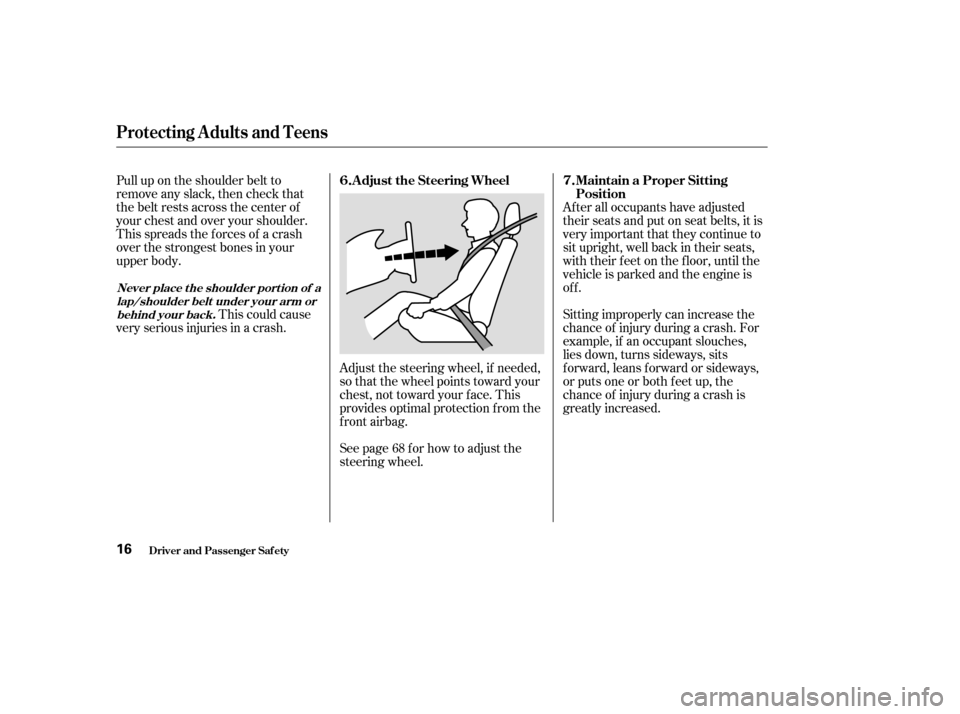Page 15 of 231

Pull up on the shoulder belt to
remove any slack, then check that
the belt rests across the center of
your chest and over your shoulder.
This spreads the f orces of a crash
over the strongest bones in your
upper body.This could cause
very serious injuries in a crash.
Adjust the steering wheel, if needed,
so that the wheel points toward your
chest, not toward your f ace. This
provides optimal protection f rom the
f ront airbag.
See page f or how to adjust the
steering wheel.After all occupants have adjusted
their seats and put on seat belts, it is
very important that they continue to
sit upright, well back in their seats,
with their feet on the floor, until the
vehicle is parked and the engine is
of f .
Sitting improperly can increase the
chance of injury during a crash. For
example, if an occupant slouches,
lies down, turns sideways, sits
forward, leans forward or sideways,
or puts one or both f eet up, the
chance of injury during a crash is
greatly increased.
68
Protecting A dults and Teens
Driver and Passenger Saf ety
Never place t he shoulder port ion of a lap/shoulder belt under your arm orbehind your back.
Adjust the Steering Wheel Maintain a Proper Sitting Position
6.
7.
16
�����—�����—�����y�
�������������y���
�(���%�������y�����
���y
Page 25 of 231

If the indicator comes on at any
other time, or does not come on at all,
you should have the system checked
by your dealer. For example:If the SRS indicator does not come
on after you turn the ignition
switch to ON (II).
If the indicator stays on after the
engine starts.
If the indicator comes on or
flashesonandoff whileyoudrive.
If you see any of these indications,
the airbags and seat belt tensioners
may not work properly when you
need them.
The SRS indicator alerts
you to a potential problem
with your f ront airbags, side airbags,
or f ront seat belt tensioners.
When you turn the ignition to ON
(II), this indicator will come on
brief ly then go out. This tells you
that the system is working properly.
Additional Inf ormation About Your Airbags
Driver and Passenger Saf ety
How the SRS Indicator Works
26
Ignoring the SRS indicator can
result in serious injury or death
if the airbag systems or
tensioners do not work properly.
Have your vehicle checked by a
dealer as soon as possible if
the SRS indicator alerts you to
a possible problem.
�����—�����—�����y�
�������������y���
�(���%�������y���������y
Page 46 of 231

Your vehicle’s exhaust contains
carbon monoxide gas. You should
have no problem with carbon
monoxide entering the vehicle in
normal driving if you maintain your
vehicle properly.
Have the exhaust system inspected
f or leaks whenever:The vehicle is raised f or an oil
change.
You notice a change in the sound
of the exhaust.
The vehicle was in an accident
that may have damaged the under-
side. High levels of carbon monoxide can
collect rapidly in enclosed areas,
such as a garage. Do not run the
engine with the garage door closed.
Even with the door open, run the
engine only long enough to move the
vehicle out of the garage. With the trunk lid open, air f low can
pull exhaust gas into your vehicle’s
interior and create a hazardous
condition. If you must drive with the
trunk lid open, open all the windows
and set the heating and cooling
system as shown below.
If you must sit in your parked vehicle,
even in an unconf ined area, with the
engine running, adjust the heating
and cooling system as f ollows:
Select the Fresh Air mode.
Select the mode.
Turn the f an on high speed.
Set the temperature control to a
comfortable setting.
1.2.3.4.
Carbon Monoxide Hazard
Driver and Passenger Saf ety47
Carbon monoxide gas is toxic.
Breathing it can cause
unconsciousness and even killyou.
Avoid any enclosed areas or
activities that expose you to
carbon monoxide.
�����—�����—�����y�
�������������y���
�(���%�������y���������y
Page 55 of 231

The instrument panel has many
indicators to give you important
inf ormation about your vehicle.If this indicator comes on when the
engine is running, the battery is not
being charged. For more inf ormation,
see page .
The engine can be severely damaged
if this indicator f lashes or stays on
when the engine is running. For
complete inf ormation, see page .
This indicator comes on when you
turn the ignition switch to ON (II). If
it comes on at any other time, it
indicates a potential problem with
your f ront airbags or automatic seat
belt tensioners. On models equipped
with side airbags, this light will also
alert you to a potential problem with
your side airbags or passenger’s side
airbag automatic cutoff system. For
complete inf ormation, see page .
This indicator comes on when you
turn the ignition switch to ON (II). If
it comes on at any other time, it
indicates that the passenger’s side
airbag has automatically shut off.
For more inf ormation, see page .
The seat belt system includes an
indicator on the instrument panel
and a beeper to remind you and your
passengers to f asten your seat belts.
If you turn the ignition switch to ON
(II) bef ore f astening your belt, the
beeper sounds and the indicator
f lashes. If you do not f asten your
seat belt bef ore the beeper stops, the
indicator stops f lashing but remainson.
If you continue driving without
f astening your seat belt, the beeper
sounds and the indicator f lashes
again at regular intervals.
26
27 195
195
Only on models equipped with side
airbags
Supplemental Restraint
System Indicator Charging System
Indicator
L ow Oil Pressure
Indicator
Side Airbag Of f Indicator
Seat Belt Indicator
Inst rument s and Cont rols
Instrument Panel Indicators
56
�����—�����—�����y�
���������
���y���
�(���%�������y���������y
Page 56 of 231

This indicator has two f unctions:Itcomesonwhenyouturnthe
ignition switch ON (II). It is a
reminder to check the parking
brake. Driving with the parking
brake not f ully released can
damage the brakes and tires.
If it remains lit af ter you have f ully
released the parking brake while
the engine is running, or if it
comes on while driving, there
could be a problem with the brake
system. For complete inf ormation,
see page . This indicator comes on when you
turn the ignition switch to ON (II)
with the headlight switch off and the
parking brake set. It should go of f if
youturnontheheadlightsorrelease
the parking brake. If it comes on at
any other time, it means there is a
problem with the DRL. There may
also be a problem with the high
beam headlights.
This indicator normally comes on f or
a f ew seconds when you turn the
ignition switch to ON (II), and when
the ignition switch is turned to
START (III). If this indicator comes
on at any other time, there is a
problem in the ABS. If this happens,
take your vehicle to your dealer to
have it checked. With this indicator
on, your vehicle still has normal
braking ability but no anti-lock. For
complete inf ormation, see page .
1. 2.
197 139
Only on models equipped with ABS (see
page ) Canadian models only
139
CONT INUED
Parking Brake
and Brake
System
Indicator Anti-lock Brake System
(A BS) Indicator
‘‘Daytime Running
Lights’’ Indicator
Inst rument s and Cont rols
Instrument Panel Indicators
57
U.S. Canada
�����—�����—�����y�
�������������y���
�(���%�������y���������y
Page 58 of 231
This indicator comes on f or a f ew
seconds when you turn the ignition
switch to ON (II). It will go of f if you
have inserted a properly-coded
ignition key. If it is not a properly-
coded key, the indicator will blink
and the engine will not start (see
page ).
This indicator also blinks several
times when you turn the ignition
switch f rom ON (II) to ACCESSORY
(I) or LOCK (0).70Immobilizer System
Indicator
Inst rument s and Cont rols
Instrument Panel Indicators
59
�����—�����—�����y�
�������������y���
�(���%�������y���������y
Page 59 of 231

The odometer shows the total dis-
tance your vehicle has been driven.
It measures miles in U.S. models and
kilometers in Canadian models.
It is illegal under U.S. f ederal law and
Canadian provincial regulations to
disconnect, reset, or alter the
odometer with the intent to change
the number of miles or kilometers
indicated.The trip meter shows the number of
miles (U.S.) or kilometers (Canada)
driven since you last reset it.
There are two trip meters: Trip A
and Trip B. Each trip meter works
independently, so you can keep track
of two dif f erent distances.
To reset a trip meter, display it and
then press and hold the Select/Reset
knob until the number resets to ‘‘0.0’’.
This shows how much f uel you have.
It may show slightly more or less
than the actual amount. The needle
returns to the bottom after you turn
of f the ignition.
The odometer and the trip meters
use the same display. Switch
between these displays by pressing
the Select/Reset knob.
Gauges
Odometer/T rip Meter
Fuel Gauge
U.S.:HX,LX,EX,Canada:LX,Si
Inst rument s and Cont rols60
TEMPERATURE GAUGE
FUEL GAUGE
ODOMETER/TRIP METER
The U.S. instrument
panel is shown. TACHOMETER
SPEEDOMETER
SELECT/RESET KNOB
Avoid driving with an extremely low
f uel level. Running out of f uel could
cause the engine to misf ire, damaging
the catalytic converter.
�����—�����—�����y�
�������������y���
�(���%�������y���������y
Page 60 of 231
This shows the temperature of the
engine’s coolant. During normal
operation, the pointer should rise to
about the middle of the gauge. In
severe driving conditions, the pointer
may rise to the upper zone. If it
reaches the red (Hot) mark, pull
safely to the side of the road. Turn to
page f or instructions and
precautions on checking the engine’s
cooling system.157
Gauges
Inst rument s and Cont rols
Temperature Gauge
Canadian DX
U.S. DX
61
SPEEDOMETER
SELECT/RESET KNOB
TACHOMETER
TEMPERATURE
GAUGE
ODOMETER/TRIP METER FUEL GAUGE
FUEL GAUGE
SPEEDOMETER
TEMPERATURE
GAUGE
ODOMETER/TRIP METER SELECT/RESET KNOB
�����—�����—�����y�
���������
���y���
�(���%�������y���������y